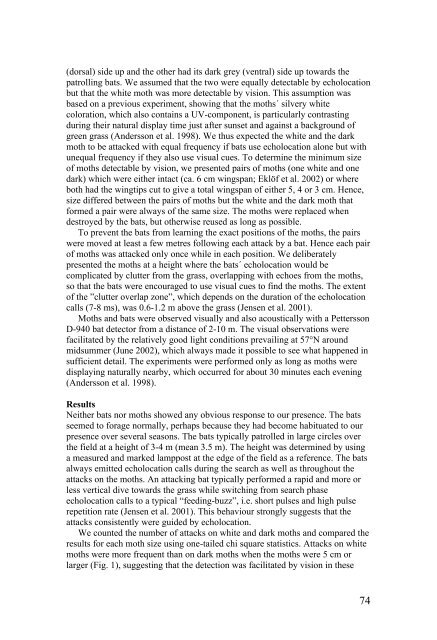Vision in echolocating bats - Fladdermus.net
Vision in echolocating bats - Fladdermus.net
Vision in echolocating bats - Fladdermus.net
You also want an ePaper? Increase the reach of your titles
YUMPU automatically turns print PDFs into web optimized ePapers that Google loves.
(dorsal) side up and the other had its dark grey (ventral) side up towards the<br />
patroll<strong>in</strong>g <strong>bats</strong>. We assumed that the two were equally detectable by echolocation<br />
but that the white moth was more detectable by vision. This assumption was<br />
based on a previous experiment, show<strong>in</strong>g that the moths´ silvery white<br />
coloration, which also conta<strong>in</strong>s a UV-component, is particularly contrast<strong>in</strong>g<br />
dur<strong>in</strong>g their natural display time just after sunset and aga<strong>in</strong>st a background of<br />
green grass (Andersson et al. 1998). We thus expected the white and the dark<br />
moth to be attacked with equal frequency if <strong>bats</strong> use echolocation alone but with<br />
unequal frequency if they also use visual cues. To determ<strong>in</strong>e the m<strong>in</strong>imum size<br />
of moths detectable by vision, we presented pairs of moths (one white and one<br />
dark) which were either <strong>in</strong>tact (ca. 6 cm w<strong>in</strong>gspan; Eklöf et al. 2002) or where<br />
both had the w<strong>in</strong>gtips cut to give a total w<strong>in</strong>gspan of either 5, 4 or 3 cm. Hence,<br />
size differed between the pairs of moths but the white and the dark moth that<br />
formed a pair were always of the same size. The moths were replaced when<br />
destroyed by the <strong>bats</strong>, but otherwise reused as long as possible.<br />
To prevent the <strong>bats</strong> from learn<strong>in</strong>g the exact positions of the moths, the pairs<br />
were moved at least a few metres follow<strong>in</strong>g each attack by a bat. Hence each pair<br />
of moths was attacked only once while <strong>in</strong> each position. We deliberately<br />
presented the moths at a height where the <strong>bats</strong>´ echolocation would be<br />
complicated by clutter from the grass, overlapp<strong>in</strong>g with echoes from the moths,<br />
so that the <strong>bats</strong> were encouraged to use visual cues to f<strong>in</strong>d the moths. The extent<br />
of the ”clutter overlap zone”, which depends on the duration of the echolocation<br />
calls (7-8 ms), was 0.6-1.2 m above the grass (Jensen et al. 2001).<br />
Moths and <strong>bats</strong> were observed visually and also acoustically with a Pettersson<br />
D-940 bat detector from a distance of 2-10 m. The visual observations were<br />
facilitated by the relatively good light conditions prevail<strong>in</strong>g at 57°N around<br />
midsummer (June 2002), which always made it possible to see what happened <strong>in</strong><br />
sufficient detail. The experiments were performed only as long as moths were<br />
display<strong>in</strong>g naturally nearby, which occurred for about 30 m<strong>in</strong>utes each even<strong>in</strong>g<br />
(Andersson et al. 1998).<br />
Results<br />
Neither <strong>bats</strong> nor moths showed any obvious response to our presence. The <strong>bats</strong><br />
seemed to forage normally, perhaps because they had become habituated to our<br />
presence over several seasons. The <strong>bats</strong> typically patrolled <strong>in</strong> large circles over<br />
the field at a height of 3-4 m (mean 3.5 m). The height was determ<strong>in</strong>ed by us<strong>in</strong>g<br />
a measured and marked lamppost at the edge of the field as a reference. The <strong>bats</strong><br />
always emitted echolocation calls dur<strong>in</strong>g the search as well as throughout the<br />
attacks on the moths. An attack<strong>in</strong>g bat typically performed a rapid and more or<br />
less vertical dive towards the grass while switch<strong>in</strong>g from search phase<br />
echolocation calls to a typical “feed<strong>in</strong>g-buzz”, i.e. short pulses and high pulse<br />
repetition rate (Jensen et al. 2001). This behaviour strongly suggests that the<br />
attacks consistently were guided by echolocation.<br />
We counted the number of attacks on white and dark moths and compared the<br />
results for each moth size us<strong>in</strong>g one-tailed chi square statistics. Attacks on white<br />
moths were more frequent than on dark moths when the moths were 5 cm or<br />
larger (Fig. 1), suggest<strong>in</strong>g that the detection was facilitated by vision <strong>in</strong> these<br />
74


